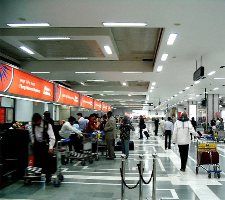 These may either replace existing airports or run simultaneously.
These may either replace existing airports or run simultaneously.
Operators developing greenfield airports (built from scratch on undeveloped land) are likely to face increased competition, with the Ministry of Civil Aviation considering tweaking the norms to allow such airports to be developed within 150-km radii of existing ones.
According to norms in the ‘policy on airport infrastructure of India’, the government will approve the establishment of greenfield airports in places where an existing one is unable to meet the projected requirements of traffic or in case a ‘new focal point of traffic emerges with sufficient viability’.
This could either be as a replacement for an existing airport, or for simultaneous operations.
The current policy states, “No greenfield airport will normally be allowed within an aerial distance of 150 km of an existing airport.
“Where it is allowed as a second airport in the same city or close vicinity, the parameters for distribution of traffic between the two airports will be clearly spelt out.”
A senior ministry official said, “In the case of existing airports that are operated by private players, we will honour the concession agreement.
“If there is a need to develop a second airport within a 150-km radius, we will take the stakeholders into confidence and look at ways to resolve the issue; for instance, by granting them the first right of refusal for developing the new airport.
“But in all other cases, the steering committee will take the final decision regarding granting an in-principle approval to greenfield airport projects, even if they are within 150-km radii of each other.”
While all concession agreements with private operators at brownfield airports (rebuilt or expanded on an existing facilities) such as those in Delhi, Bangalore and Hyderabad will be ‘honoured’, a steering committee headed by the civil aviation secretary will evaluate the various effects of such new airports on existing ones (if it is within a 150-km radius), including the impact on traffic, before giving an in-principle approval.
Ramesh Vaidyanathan, managing partner, Advaya Legal, said, “The effect of doing away with this requirement is it will increase competitiveness, as well as connectivity. Further, this might be a disincentive to investment in this sector, as the private operator will no longer have exclusivity.”
The policy on airport infrastructure also states the government might, while permitting a greenfield airport, decide whether is in the public or private sector, or be taken up as a joint venture.
“If greenfield airports are considered for smaller cities by the Airports Authority of India, it is unlikely there will be any problem.
“However, at bigger airports, private players may be hesitant in making large investments, as non-inclusion of a no-compete clause will lessen the financial attractiveness of the project,” said Amrit Pandurangi, senior director, Deloitte Touche Tomatsu.
The government plans to increase air connectivity by developing budget airports in smaller cities across the country.
It has said to tap into the resources and expertise of the private sector, it will encourage participation from this segment.
While an institutional framework will be established for this, regulators will be given greater autonomy, as well as accountability.
“The limitation of not allowing a greenfield airport in a 150-km radius of an existing one is likely to be relaxed for airports coming up.
“This will be of great help to travellers and we may see a lot of new airports coming up in smaller cities, leading to the establishment of an expansive network,” said an AAI official.
Infrastructure creation through modernisation of existing airports and the development of low-cost airports to promote air connectivity, particularly to remote areas, is priority for the Narendra Modi-led government.
The Bharatiya Janata Party’s election manifesto had mentioned the “potential for (developing) inland air transportation to various remote and local locations in the country.
“Such air strips will be developed so that low-cost air travelling becomes possible within the country”.
NEW HORIZONS
- New greenfield airports will be allowed when an existing airport is unable to meet projected traffic requirements
- These could also be approved in case a “new focal point of traffic emerges with sufficient viability”
- A steering committee will decide on granting in-principle approval to greenfield airport project
- Shareholders in existing airports will be granted the first right of refusal for developing a new airport
Image: Delhi Airport ' Photograph: Courtesy,Kprateek88/Wikimedia Commons
Please click here for the Complete Coverage of Budget 2014 -15












 © 2025
© 2025